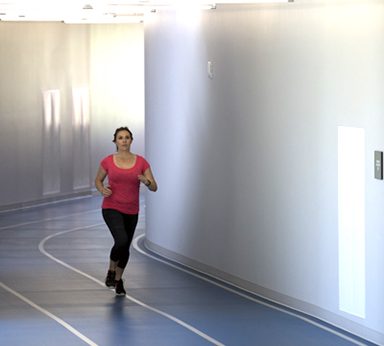Light-intensity activities such as washing the dishes, making the bed, and walking the dog may play a significant role in helping people maintain weight loss, according to a study by researchers at the Colorado School of Public Health (ColoradoSPH) and the University of Colorado Anschutz Health and Wellness Center.
The researchers noted that moderate-to-vigorous physical activity has been shown to strongly correlate with long-term weight-loss maintenance, but few studies have examined patterns of light-intensity activity and sedentary behavior in people who successfully keep the pounds off.
 Simple light-intensity activities such as walking the dog could play a significant role in helping maintain weight loss.
Simple light-intensity activities such as walking the dog could play a significant role in helping maintain weight loss.
“We conducted the study to better understand whether patterns of light-intensity activity and sedentary behavior were different in those who were successfully maintaining a weight loss compared to those who are not,” said Danielle Ostendorf, a CU Anschutz doctoral student in epidemiology who worked on the study.
Three groups of participants
In the National Institute of Health (NIH)-funded study (Principle Investigator Victoria A. Catenacci, MD), subjects wore a small, lightweight activity monitor (activPALTM, PAL Technologies LTD, Glasgow, Scotland) for seven days as they went about their normal activities. Participants were drawn from three groups:
- weight-loss maintainers (individuals who had lost at least 30 pounds and were maintaining that weight loss for at least two years);
- controls of normal body weight (matched to the current Body Mass Index (BMI) of the weight-loss maintainers);
- controls with overweight/obesity (matched to the pre-weight-loss BMI of the maintainers).
Data from the 90 healthy adults in their mid-40s was collected and analyzed at the Center, with all three groups having a similar number of participants and distribution of age and sex. In a study such as this, it is critical to have groups with similar age and sex make-up, as physical activity varies by both age and sex.
Catenacci, a Department of Medicine faculty member in endocrinology, was lead author of the abstract. Ostendorf presented the abstract’s findings at the recent annual American Public Health Association conference in Denver.
Surprising results
“We had hypothesized that the weight-loss maintainers would be significantly different than the other two groups in terms of sedentary behavior and light activity,” Ostendorf said. “What was surprising was that the weight-loss maintainers and normal weight controls were similar in terms of their overall sedentary time and their time spent doing light activity, but differed dramatically from the controls with overweight/obesity in these parameters.”
 A woman works out on a treadmill at the University of Colorado Anschutz Health and Wellness Center.
A woman works out on a treadmill at the University of Colorado Anschutz Health and Wellness Center.
The weight-loss maintainers and normal weight controls spent 4.8 hours (290 minutes) and 4.7 hours (281 minutes) a day doing light-intensity activity, respectively, while they were sedentary for 9.9 hours (596 minutes) and 10.3 hours (617 minutes) a day. The overweight/obese control arm spent 3.9 hours (234 minutes) a day in light-intensity activity and 10.9 hours (654 minutes) a day being sedentary. Compared to the controls with overweight/obesity, weight-loss maintainers and normal weight controls were doing about one hour more of light activity and one hour less of sedentary time each day.
[cucalloutbox align="left" color="" class="" size=""]
Top student abstract
Danielle Ostendorf won the “Outstanding Student Research in Physical Activity” award at the recent American Public Health Association conference in Denver. It was selected among the top three student abstracts at the October conference.
[/cucalloutbox]
Consistent with other studies, weight-loss maintainers also engaged in more exercise than controls of both types. Weight-loss maintainers spent 38.8 minutes a day doing moderate-to-vigorous exercise (accumulated in sustained bouts of 10 minute or more) compared to 16.7 minutes a day for the normal control group and just nine minutes a day for the controls with overweight/obesity.
Citing U.S. Office of Disease Prevention and Health Promotion (ODPHP) guidelines, Ostendorf said moderate-to-vigorous exercise is emphasized when it comes to maintaining weight loss. For example, the ODPHP recommends that weight-loss maintainers do 300 minutes of moderate-intensity aerobic activity (such as brisk walking, jogging, or swimming laps) each week compared to the 150 minutes of comparable activity for people in a normal weight range.
Benefits of light-intensity activities
The 300-minute guideline can be intimidating for people who are trying to maintain their weight loss, especially for those who struggle to exercise in a moderate to vigorous manner, Ostendorf said. “The fact that people may benefit from increasing light-intensity activities like doing household chores or taking the dog for a walk is encouraging information,” she said. “However, future weight loss interventions need to test whether increasing light-intensity activities can help people maintain weight loss.”
As part of her dissertation, Ostendorf plans to test the 300 minutes of moderate-intensity exercise guideline for weight-loss maintenance. She wonders if a lower amount of moderate-intensity activity, when coupled with less time being sedentary and more time doing light-intensity activity, would be just as effective in maintaining weight loss.
 A woman runs the track at the University of Colorado Anschutz Health and Wellness Center.
A woman runs the track at the University of Colorado Anschutz Health and Wellness Center.
The potential exists, Ostendorf believes, to incorporate both reduced sedentary behavior and increased light-intensity activity into the ODPHP maintenance guidelines. “This would lead to future weight-loss interventions that people can do at the workplace, or at home because it involves physical activity that doesn’t require people to get their heart rate up, which can be uncomfortable for some people,” she said.
Not typically examined
Light-intensity activity is typically not examined in weight-loss maintenance studies because it’s more difficult to monitor than heart-pumping moderate-to-vigorous exercise. “Light-intensity activity is like walking in a grocery store – it’s movement, but it’s not really getting the heart rate up,” Ostendorf said.
She said workplace interventions, such as standing at your desk and taking more frequent breaks from sitting, can be beneficial to help break up dangerous sedentary behaviors. These easy-to-implement interventions would be helpful for health care professionals as they consult with patients about how to keep shed pounds from coming back.
“Understanding how people maintain weight loss is really important,” Ostendorf said. “If we can have an impact on helping people maintain their weight loss then we can help prevent chronic disease and early mortality. Excess weight is connected to so many disease pathways.”




